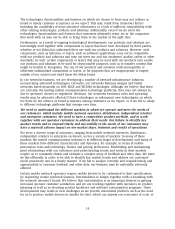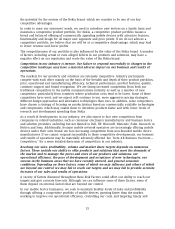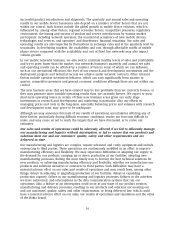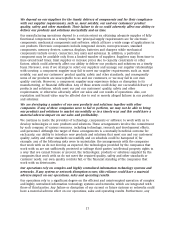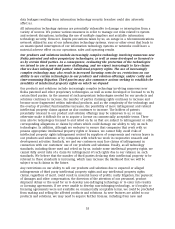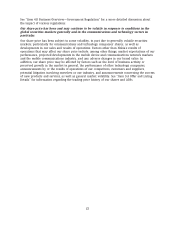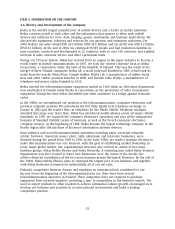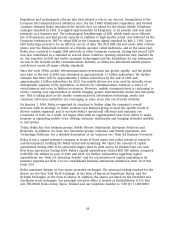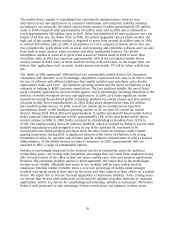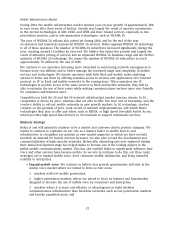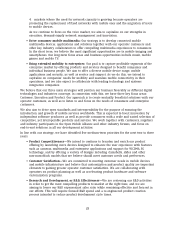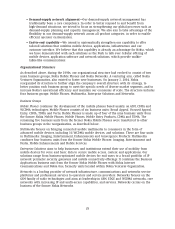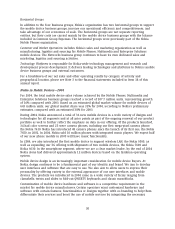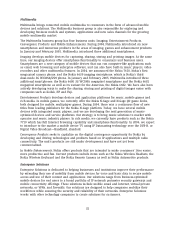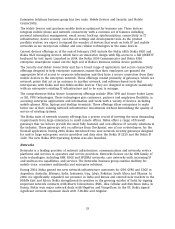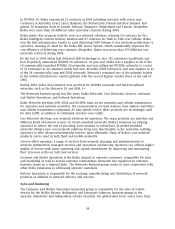Nokia 2004 Annual Report Download - page 25
Download and view the complete annual report
Please find page 25 of the 2004 Nokia annual report below. You can navigate through the pages in the report by either clicking on the pages listed below, or by using the keyword search tool below to find specific information within the annual report.Regulatory and technological reforms also have played a role in our success. Deregulation of the
European telecommunications industries since the late 1980s stimulated competition and boosted
customer demand. Nokia introduced the world’s first car phone for the Nordic Mobile Telephone
analogue standard in 1982. It weighed approximately 10 kilograms, or 22 pounds, and was used
primarily as a business tool. The technological breakthrough of GSM, which made more efficient
use of frequencies and had greater capacity in addition to high quality sound, was followed by the
European resolution in 1987 to adopt GSM as the European digital standard by July 1, 1991. Later,
GSM technology proved to be an efficient carrier of data. The first GSM call was made with a Nokia
phone over the Nokia-built network of a Finnish operator called Radiolinja, and in the same year,
Nokia won contracts to supply GSM networks in other European countries. During this period, GSM
was also established as a standard in several Asian countries, opening important new markets for
us. Our expertise in GSM and earlier analogue technologies laid the foundation for our subsequent
success in the broader mobile communications industry, as Nokia has introduced mobile phones
and devices across all major cellular standards.
Since the early 1990s, mobile telecommunications penetration has grown rapidly, and the global
user base at the end of 2004 was estimated at approximately 1.7 billion subscribers. We further
estimate that there will be approximately 2 billion subscribers by the end of 2005 and
approximately 3 billion subscribers by 2010. Our mobile devices are now used by virtually every
demographic segment of the population, as devices for communications, business, a source of
entertainment and even as fashion accessories. Moreover, mobile communications is continuing to
evolve, creating new opportunities in mobile imaging, games, entertainment, media and enterprise
use. This is taking place as the mobile communications, information technology, media and
consumer electronics industries are converging in some areas into one broader industry.
On January 1, 2004, Nokia reorganized its structure to further align the company’s overall
structure with its strategy, to better position each business group to meet the specific needs of
diverse market segments, and to increase Nokia’s operational efficiency and maintain our
economies of scale. As a result, we began 2004 with an organizational base from which to make
progress in expanding mobile voice, driving consumer multimedia and bringing extended mobility
to enterprises.
Today, Nokia has four business groups: Mobile Phones; Multimedia; Enterprise Solutions and
Networks. In addition, we have two horizontal groups: Customer and Market Operations and
Technology Platforms. For a detailed description of our business, see ‘‘Item 4.B Business Overview.’’
Nokia is not a capital-intensive company in terms of fixed assets, but rather invests in research
and development, building the Nokia brand and marketing. We expect the amount of capital
expenditure during 2005 to be somewhat higher than in 2004 and to be funded from our cash
flow from operations. During 2004, Nokia’s capital expenditures totaled EUR 548 million compared
with EUR 432 million in each of 2003 and 2002. For further information regarding capital
expenditures see ‘‘Item 5.A Operating Results’’ and for a description of capital expenditures by
business segment see Note 3 to our consolidated financial statements included in Item 18 of this
Form 20-F.
Nokia maintains listings on four major securities exchanges. The principal trading markets for the
shares are the New York Stock Exchange, in the form of American Depositary Shares, and the
Helsinki Exchanges, in the form of shares. In addition, the shares are listed on the Frankfurt and
Stockholm stock exchanges. Our principal executive office is located at Keilalahdentie 4, P.O. Box
226, FIN-00045 Nokia Group, Espoo, Finland and our telephone number is +358 (0) 7 1800-8000.
24


